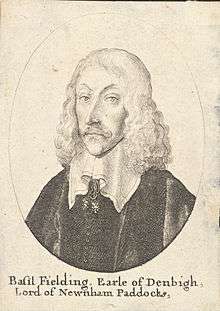Earl of Denbigh

Earl of Denbigh (pronounced "Denby") is a title in the Peerage of England. It was created in 1622 for the courtier and soldier William Feilding, 1st Viscount Feilding.
The Feilding family
The Feilding Family have been Lords of Newnham Paddox in Monks Kirby, Warwickshire since 1433.
Despite almost certainly being of Warwickshire origin, in the middle of the seventeenth century following their elevation to the aristocracy, the Feilding family began to claim descent from the Habsburgs through the counts of Laufenburg and Rheinfelden. The claim, though widely accepted at one time, including by the historian Edward Gibbon, was also the subject of ridicule. It was comprehensively debunked at the start of the twentieth century.[1][2]

Creation of the title
William Feilding was Master of the Great Wardrobe under King James I and also took part in the Expedition to Cádiz of 1625. Feilding had already been created Baron Feilding, of Newnham Paddox in the County of Warwick, and Viscount Feilding in 1620. These titles are also in the Peerage of England.
William Feilding, owed his elevation in court and to the peerage primarily to his connection with Villiers family, who were also minor Midlands gentry until George Villiers became the confidante and lover of King James 1 and was granted the dukedom of Buckingham; Susan Villiers - George's sister - married William Feilding.
Earls of Denbigh
Lord Denbigh was succeeded by his eldest son, the second Earl. In contrast to his father he fought as a Parliamentarian in the Civil War. In 1664 he was created Baron St Liz in the Peerage of England, with remainder to the heirs male of his father.
William's second son the Hon. George Feilding was created Earl of Desmond in 1628 (see below).
He died childless and was succeeded by his nephew, William Feilding, 2nd Earl of Desmond, who now also became the third Earl of Denbigh (he also succeeded in the barony of St Liz according to the special remainder). His son, the fourth Earl, served as Lord-Lieutenant of Leicestershire and Denbighshire. His great-great-grandson, the seventh Earl (the titles having descended from father to son, with the exception for the seventh Earl who succeeded his grandfather), was a soldier and courtier. His grandson, the ninth Earl, served as a Lord-in-Waiting (government whip in the House of Lords) from 1897 to 1905 in the Conservative administrations of Lord Salisbury and Arthur Balfour. As of 2010 the titles are held by his great-great-great-grandson, the twelfth Earl, who succeeded his father in 1995 (the titles having descended from father to son, with the exception for the tenth Earl who succeeded his grandfather). Lord Denbigh is Grand Carver of England.
The Hon. George Feilding, second son of the first Earl of Denbigh, was created Baron Fielding, of Lecaghe in the County of Tipperary, and Viscount Callan, of Callan in the County of Kilkenny, in 1622, and was made Earl of Desmond in 1628. All three titles were in the Peerage of Ireland. He was succeeded by his son, the second Earl, who in 1675 succeeded his uncle as third Earl of Denbigh. See above for further history of the titles.
Other members of the Feilding family may be mentioned. The writer Henry Fielding (who spelled the family name differently) was the son of Edmund Feilding, the third son of John Feilding, the youngest son of the 3rd Earl. His sister Sarah Fielding was also a well-known author, and their half-brother (Edmund's son by a different wife) was John Fielding, the celebrated blind Judge. Lady Elizabeth Feilding, daughter of the first Earl of Denbigh, was created Countess of Guilford for life in 1660. The Hon. Sir Percy Robert Basil Feilding, second son of the seventh Earl, was a General in the Army.
The family seat is at Newnham Paddox, Warwickshire.
Earls of Denbigh (1622)
- William Feilding, 1st Earl of Denbigh (1582–1643)
- Basil Feilding, 2nd Earl of Denbigh (1608–1675)
- George Feilding, 1st Earl of Desmond (c 1614-1665/6), 2nd and youngest son of the 1st Earl
- William Feilding, 3rd Earl of Denbigh and 2nd Earl of Desmond (1640–1685)
- Basil Feilding, 4th Earl of Denbigh and 3rd Earl of Desmond (1668–1717)
- William Feilding, 5th Earl of Denbigh and 4th Earl of Desmond (1697–1755)
- Basil Feilding, 6th Earl of Denbigh and 5th Earl of Desmond (1719–1800)
- William Robert Feilding, Viscount Feilding (1760–1799)
- William Basil Percy Feilding, 7th Earl of Denbigh and 6th Earl of Desmond (1796–1865)
- Rudolph William Basil Feilding, 8th Earl of Denbigh and 7th Earl of Desmond (1823–1892)
- Rudolph Robert Basil Aloysius Augustine Feilding, 9th Earl of Denbigh and 8th Earl of Desmond (1859–1939)
- William Rudolph Stephen Feilding, 10th Earl of Denbigh and 9th Earl of Desmond (1912–1966)
- William Rudolph Michael Feilding, 11th Earl of Denbigh and 10th Earl of Desmond (1943–1995)
- Alexander Stephen Rudolph Feilding, 12th Earl of Denbigh and 11th Earl of Desmond (b. 1970)
The heir apparent is the present holder's son, Peregrine Rudolph Henry Feilding, Viscount Feilding (b. 2005).
Earls of Desmond (1628)
- George Feilding, 1st Earl of Desmond (d. 1666)
- William Feilding, 2nd Earl of Desmond (1640–1685) (succeeded as Earl of Denbigh in 1675)
References
- ↑ J H Round (1901). Studies in Peerage and Family History. p. 216.
- ↑ See also image from British Library right
- Kidd, Charles, Williamson, David (editors). Debrett's Peerage and Baronetage (1990 edition). New York: St Martin's Press, 1990.
- Leigh Rayment's Peerage Pages
- Newnam Paddox Art Park
External links
- Hansard 1803–2005: contributions in Parliament by William Rudolph Stephen Feilding, 10th Earl of Denbigh
- Hansard 1803–2005: contributions in Parliament by William Rudolph Michael Feilding, 11th Earl of Denbigh